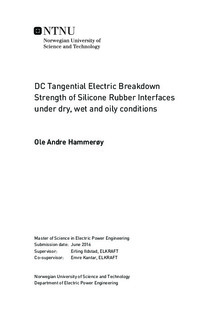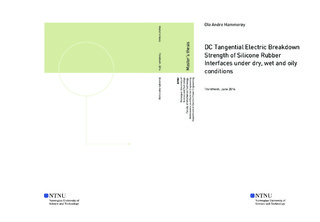| dc.contributor.advisor | Ildstad, Erling | |
| dc.contributor.advisor | Kantar, Emre | |
| dc.contributor.author | Hammerøy, Ole Andre | |
| dc.date.accessioned | 2016-10-05T14:00:25Z | |
| dc.date.available | 2016-10-05T14:00:25Z | |
| dc.date.created | 2016-06-10 | |
| dc.date.issued | 2016 | |
| dc.identifier | ntnudaim:14531 | |
| dc.identifier.uri | http://hdl.handle.net/11250/2413104 | |
| dc.description.abstract | This research work is a part of an on-going project at NTNU/SINTEF-Energy Research aim- ing at developing new criteria for design of compact high voltage subsea connectors.
Most high voltage insulation systems consists of interfaces between different solid insulators consisting of different materials. These interface connections are exposed to high voltage electric stresses either parallel or perpendicular to the surface.
The aim of this paper has been to investigate the tangential DC breakdown strength for sil- icon rubber (SiR) under dry, wet and oily interface connection conditions. This to identify how the breakdown strength are influenced by these conditions under DC voltage.
Existing research has examined the same conditions under AC voltage. These results have been used for comparison as a foundation to understand the difference between the tan- gential breakdown strength of these interfaces for AC and DC voltages.
The tangential electric breakdown strength of SiR has been examined using laboratory facil- ities and over 300 hours of HV DC experiments has been run. This has lead to comparable results showing the characteristics for the tangential electric breakdown strength for SiR un- der dry, wet and oily interface conditions.
Simulations examining the enhanced electric field strength inside the voids in the interface connection has been made using Comsol Multiphysics 5.1. This to see how the electric field strength was influenced by the different interface conditions under AC and DC voltage. The simulations has been used as a foundation to interpret the experimental breakdown strength results.
The results for dry interface condition has shown that the difference between AC and DC under such condition has a breakdown strength in the same range.
The results for wet interface conditions showed that the water filled voids acted as contam- inations at the interface connection providing high electric fields in the voids. For AC con- ditions this lead to a rapidly decomposition of the material interface causing a breakdown strength 3.5 times lower for AC than for DC.
The results for oily interface conditions showed that the oil and the SiR are such good dielec- tric materials that are quite similar. This lead to a high breakdown strength in the same area, only deviating due to minor differences between the permittivity and conductivity charac- teristics. This gave the oily interface condition a very strong tangential breakdown strength compared to the dry and wet conditions.
The estimated breakdown voltage (EBDV) has been calculated using contact theory and compared to the experimentally results for AC and DC dry interface conditions. The EBDV has been calculated using two different composite elasticity modulus É1 and É2. It has been performed to reveal the impact of elasticity modulus on the break down voltage (BDV) both theoretically and experimentally as well as to show the agreement between theory and ex- periments. The results showed that the contact theory was not reliable for estimating the in- terfacial breakdown voltage for dry interface conditions. It was not able to reveal the impact of the elasticity modulus when the results estimated the best fit breakdown voltage using the elasticity modulus that was 4 time higher than the experimentally measured value for SiR. | |
| dc.language | eng | |
| dc.publisher | NTNU | |
| dc.subject | Master of Science in Electric Power Engineering, Elektrisk Energiteknikk | |
| dc.title | DC Tangential Electric Breakdown Strength of Silicone Rubber Interfaces under dry, wet and oily conditions | |
| dc.type | Master thesis | |
| dc.source.pagenumber | 68 | |

